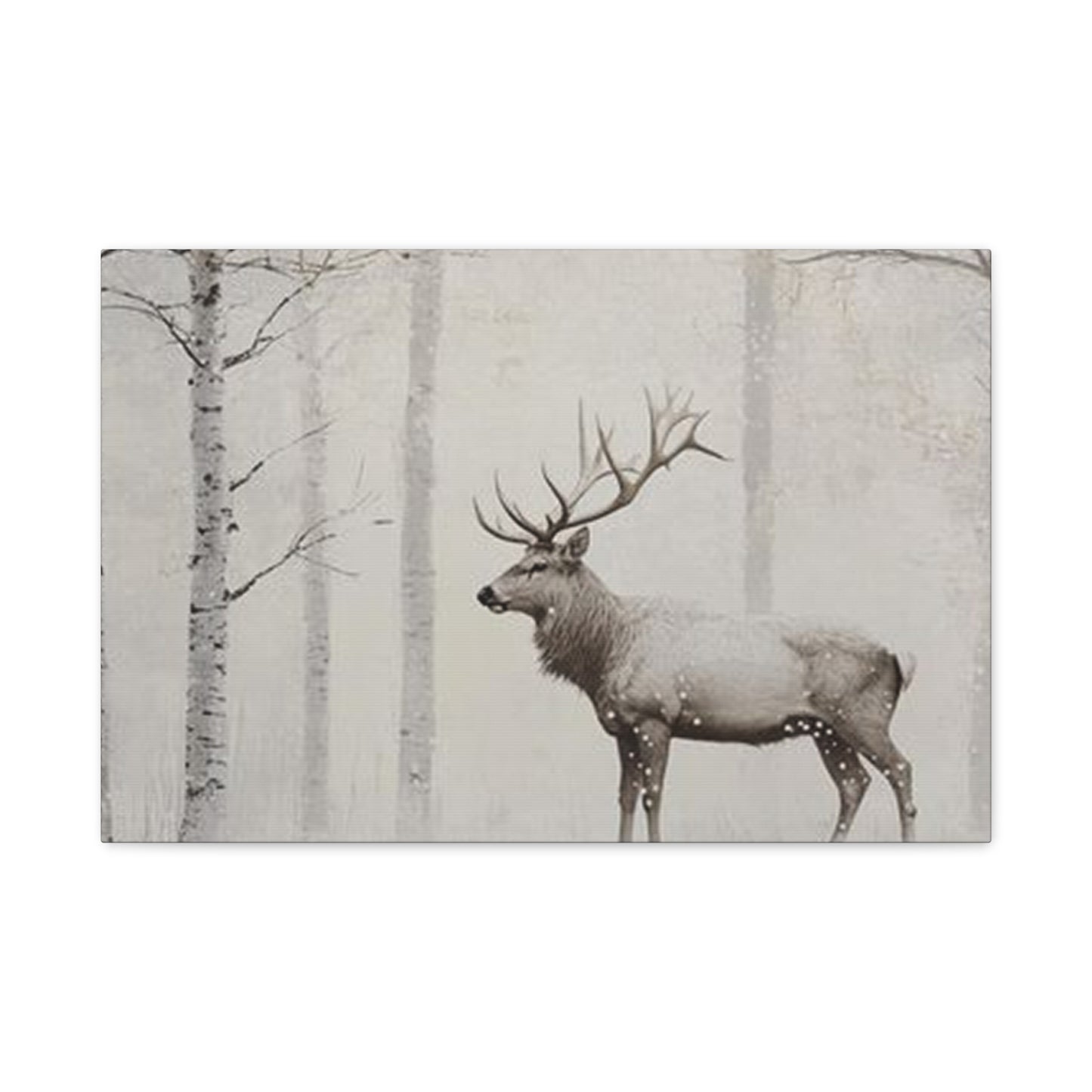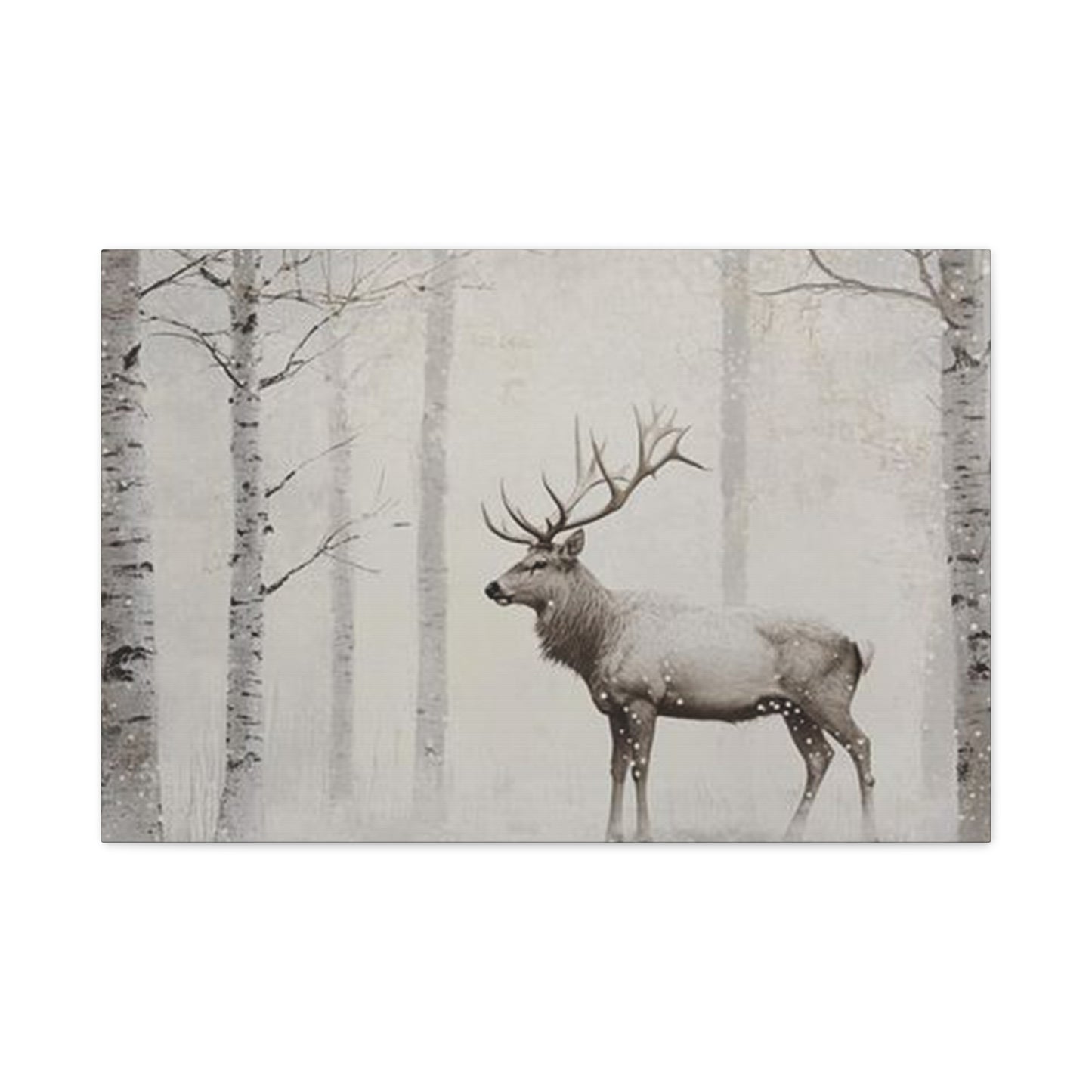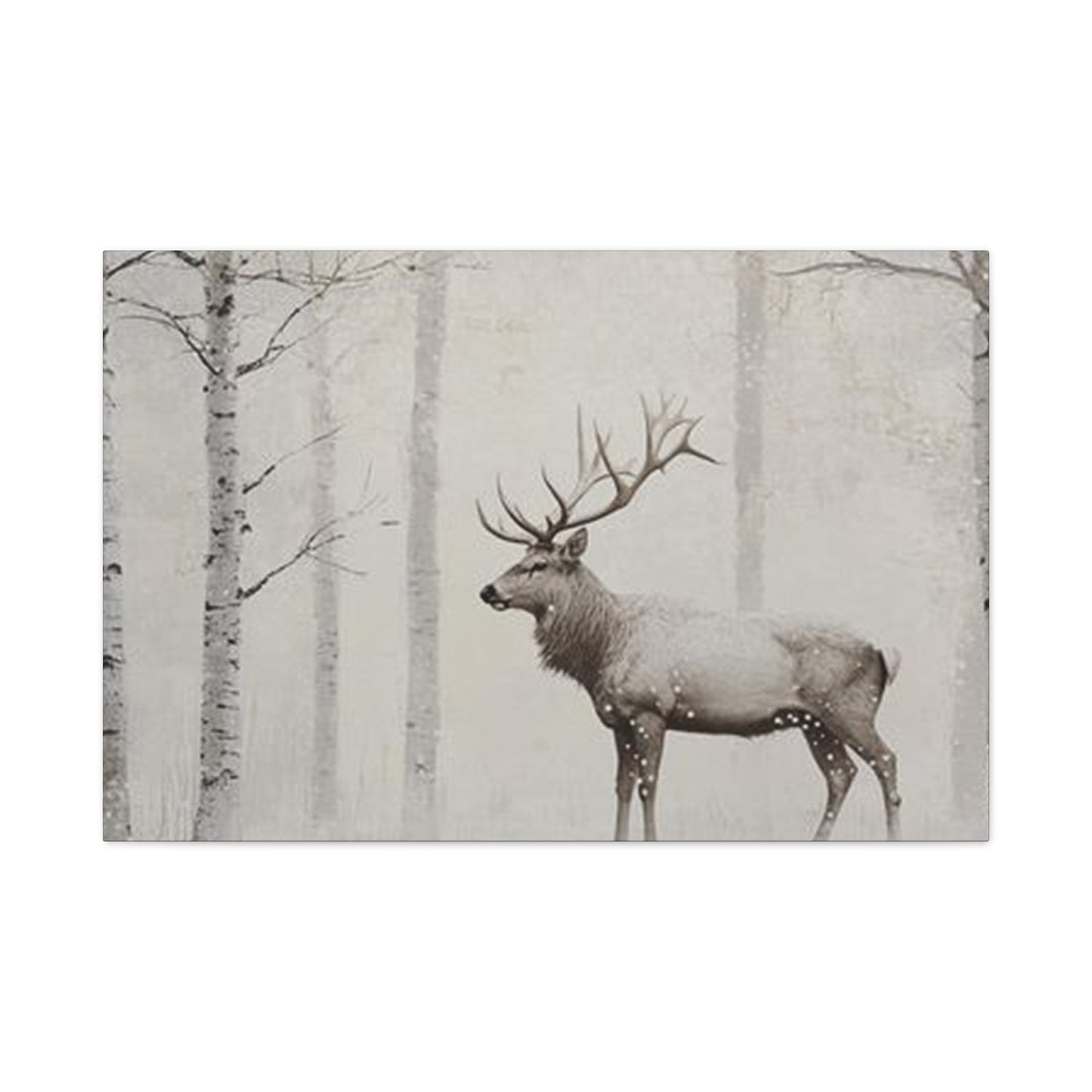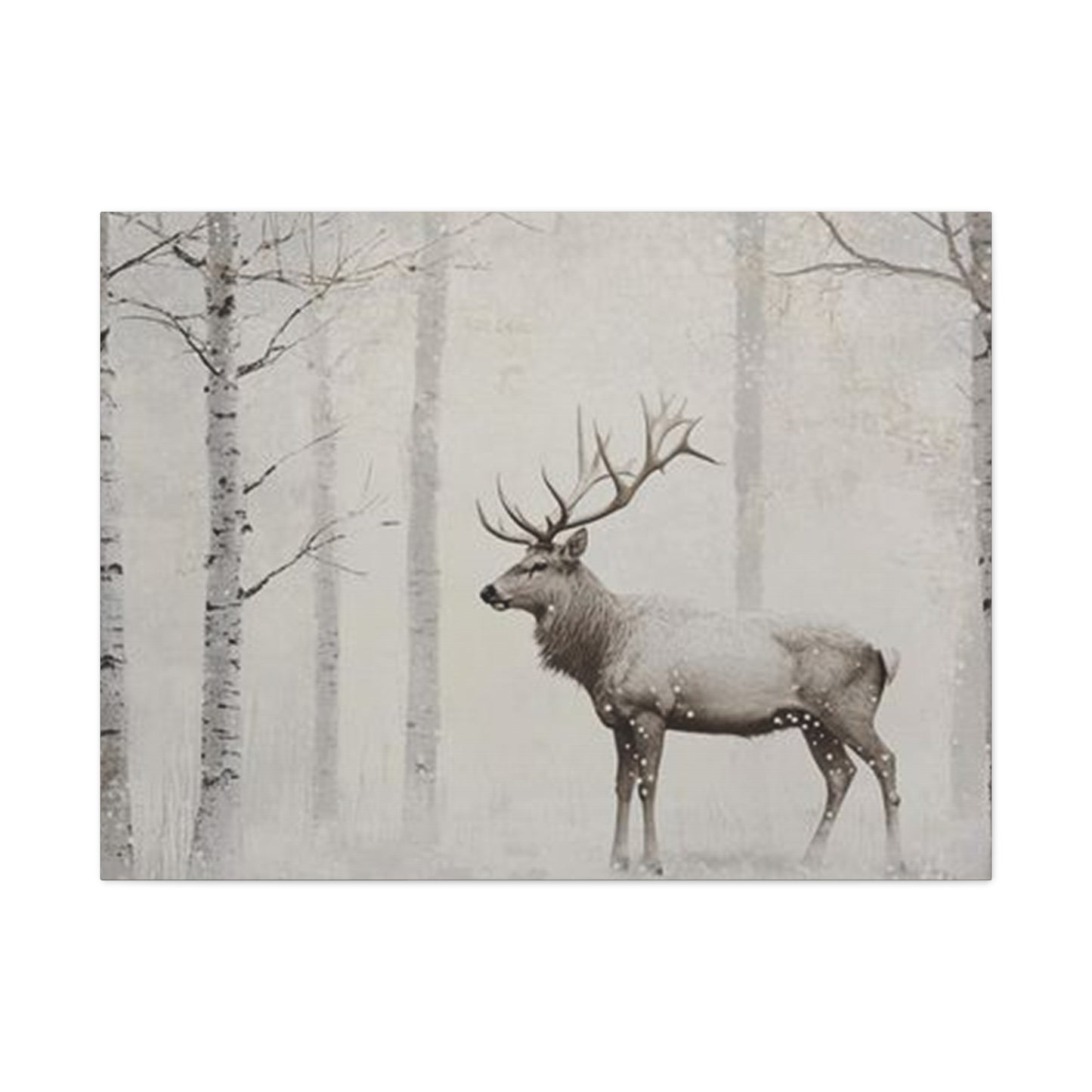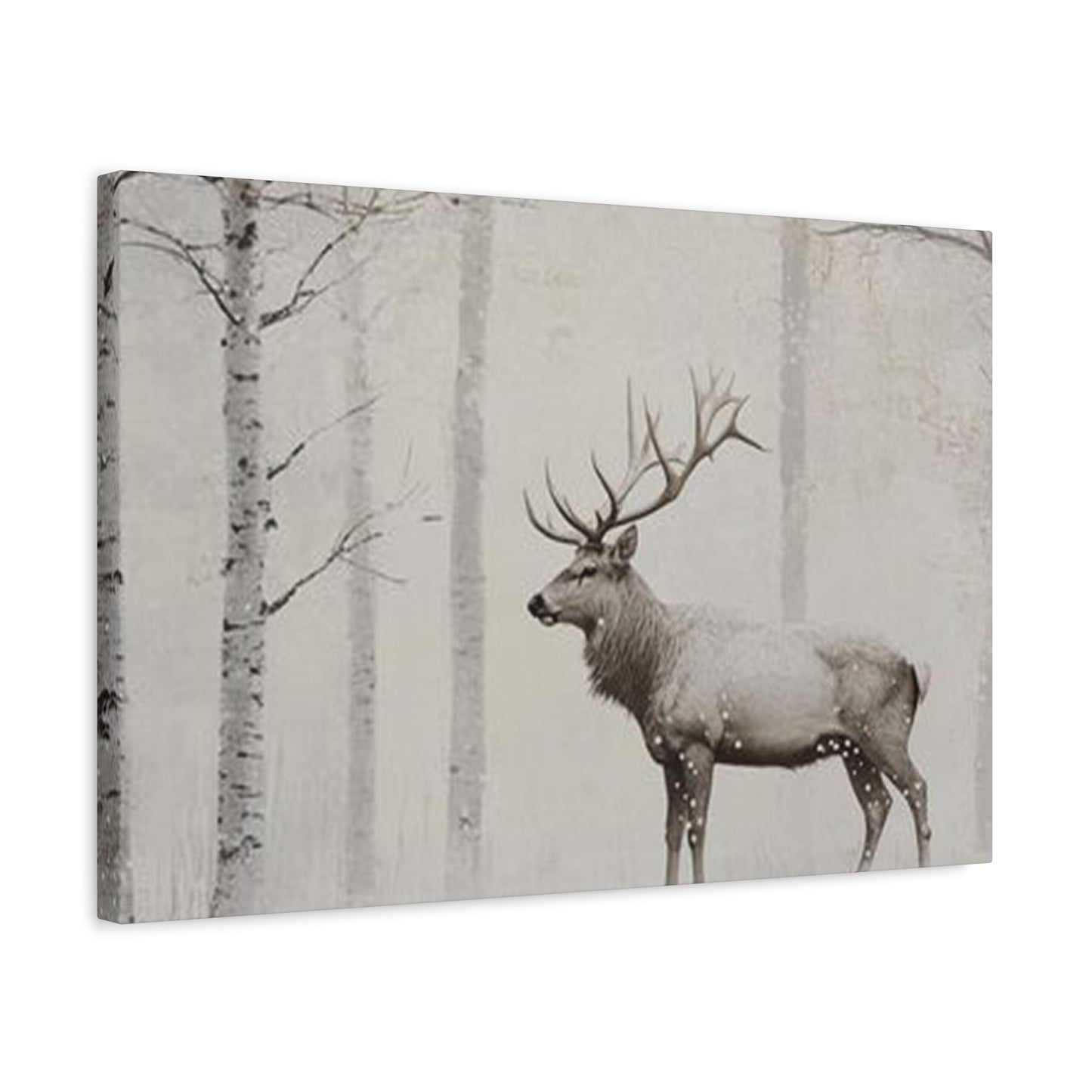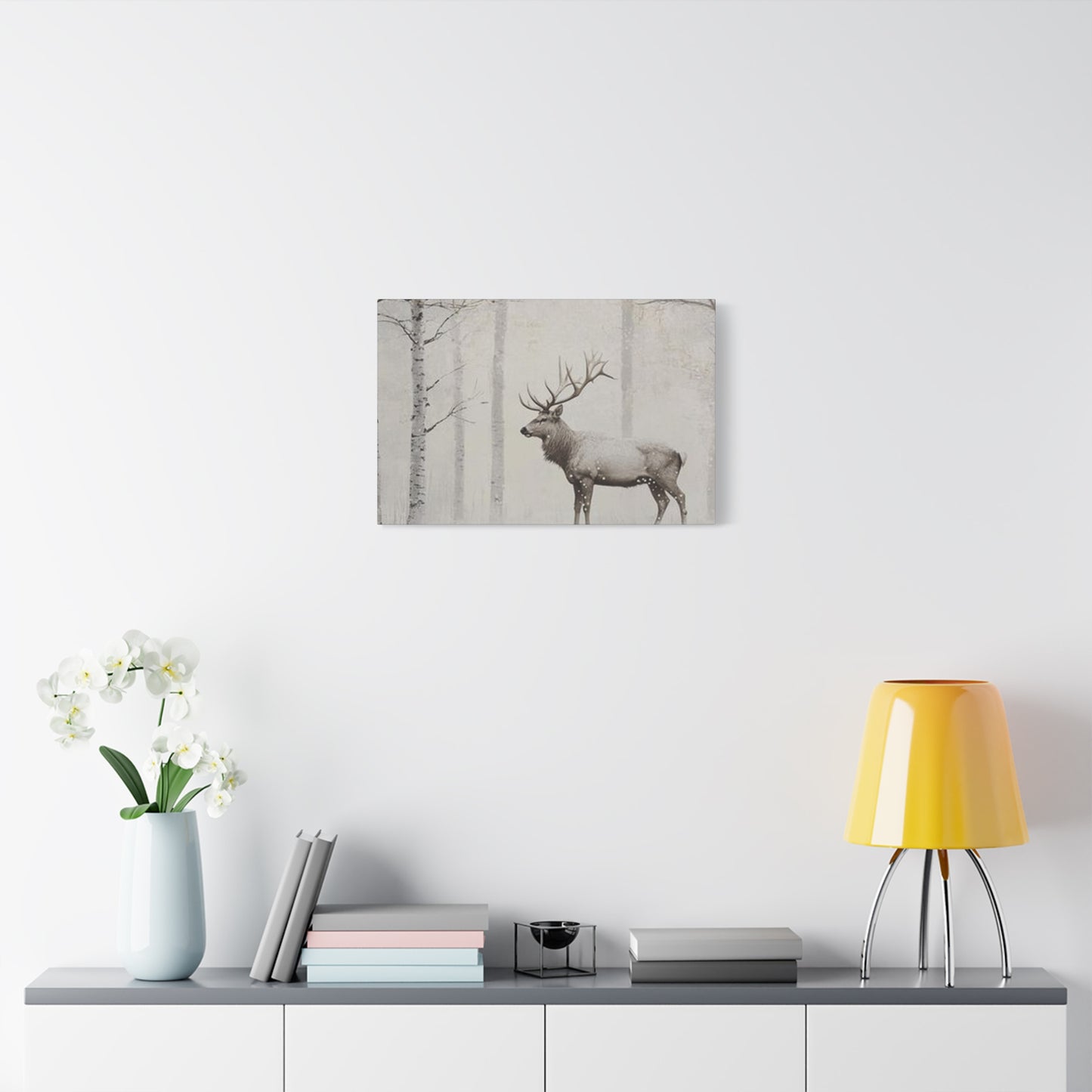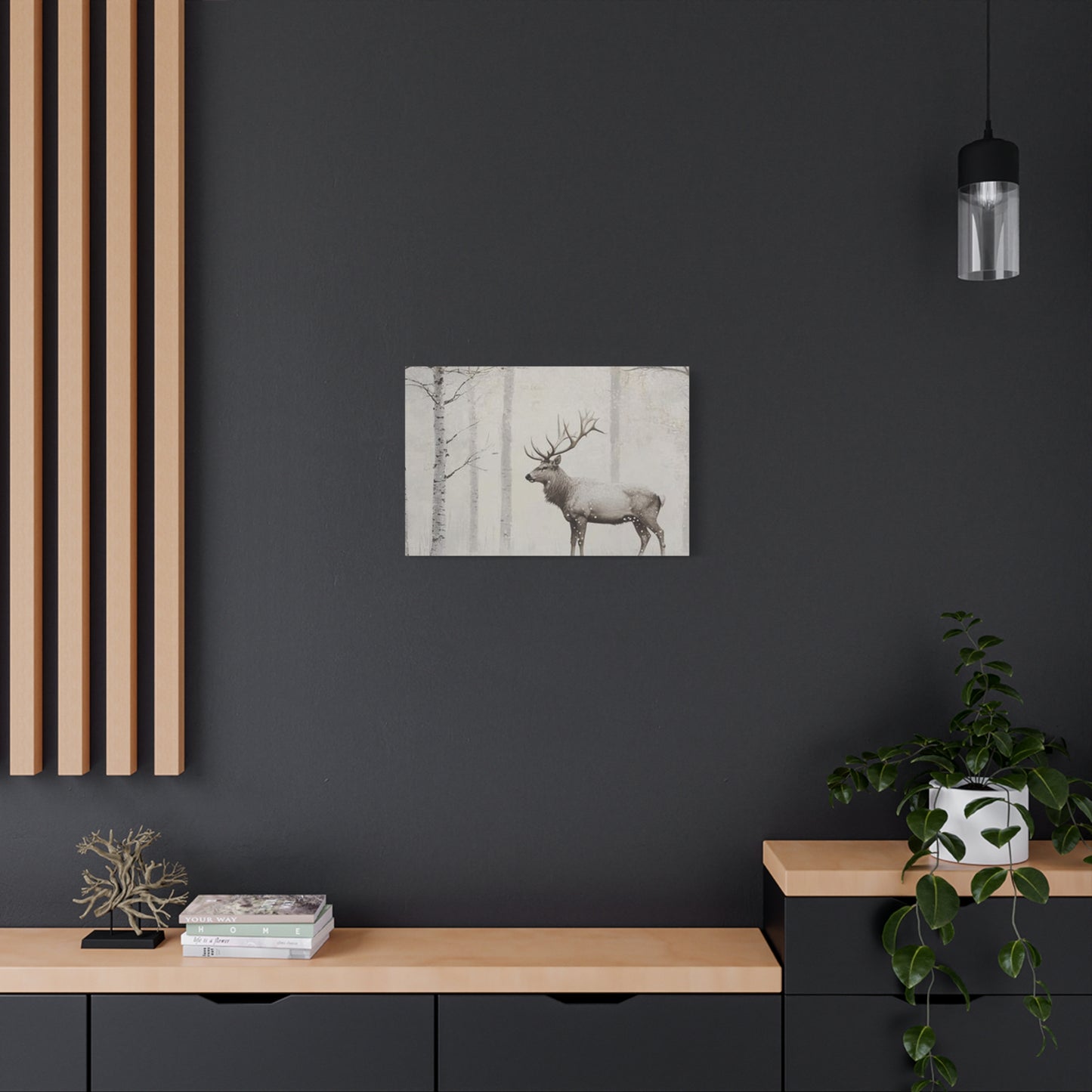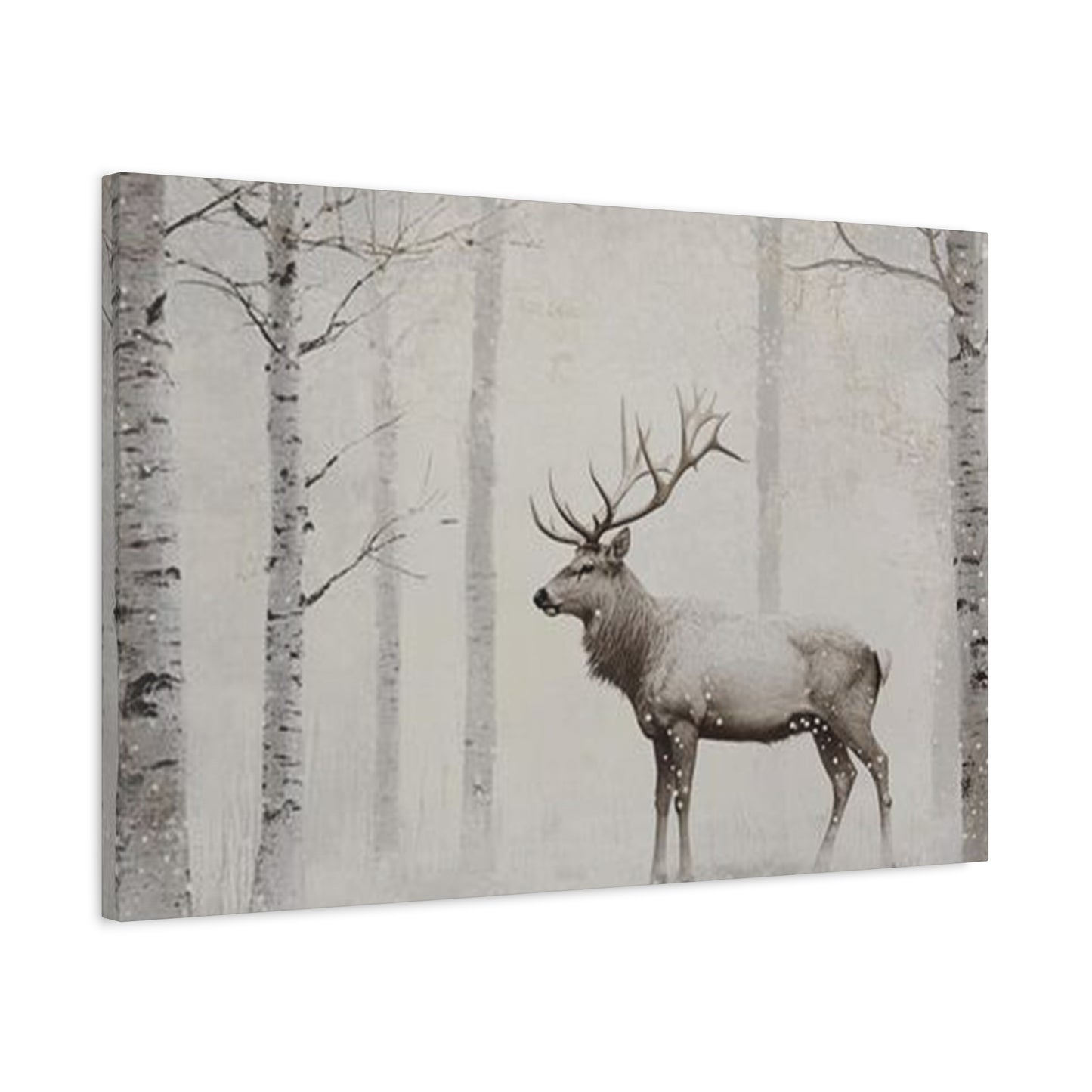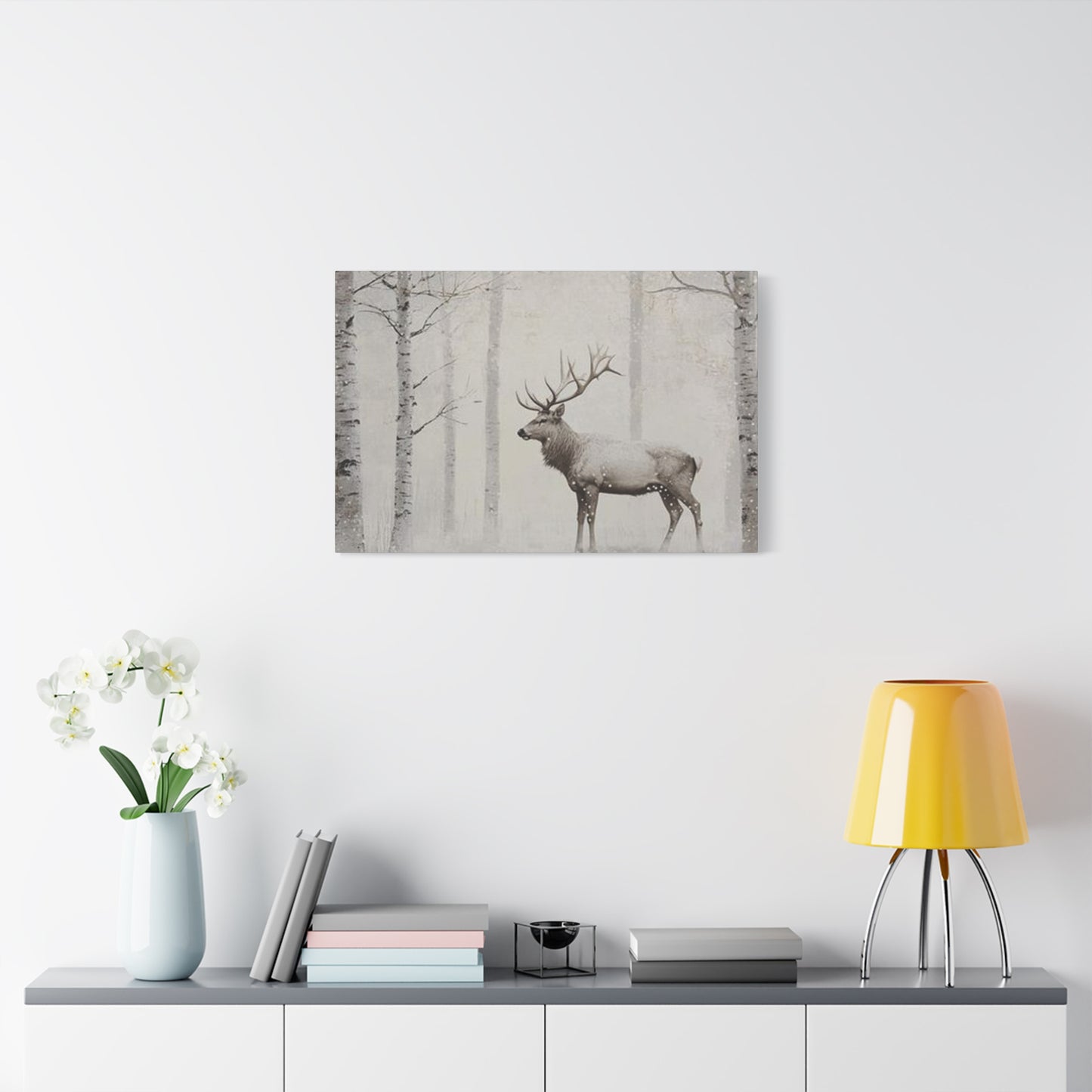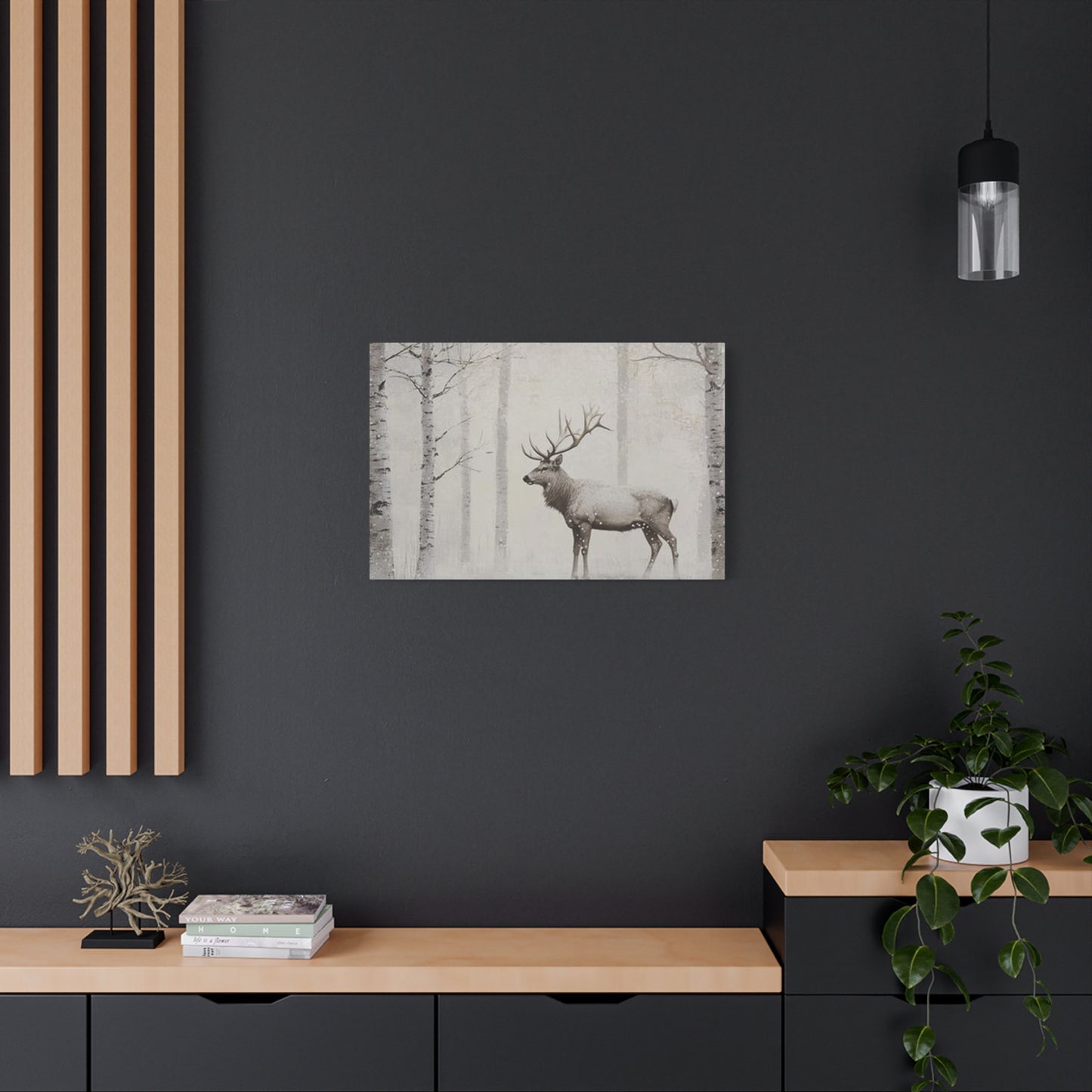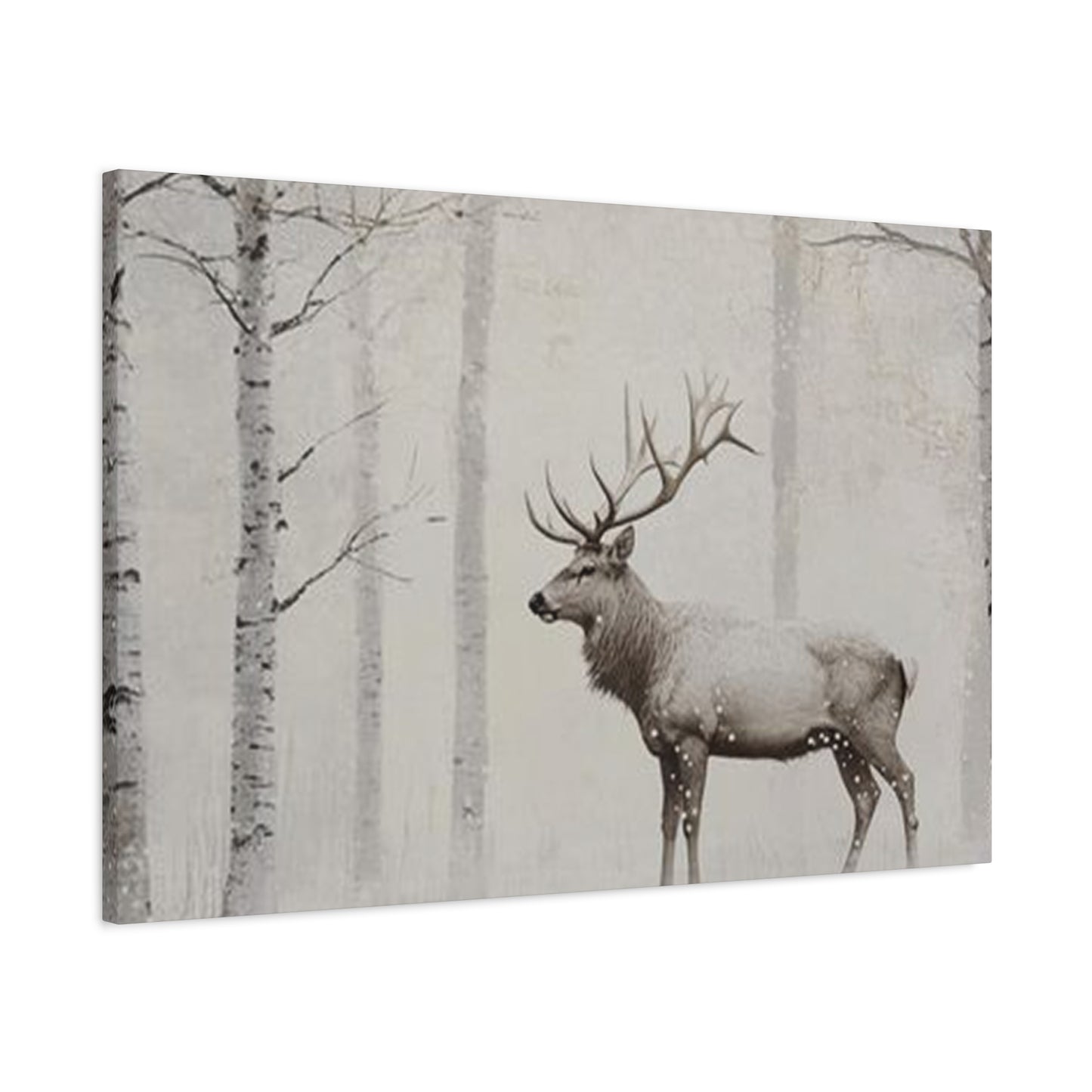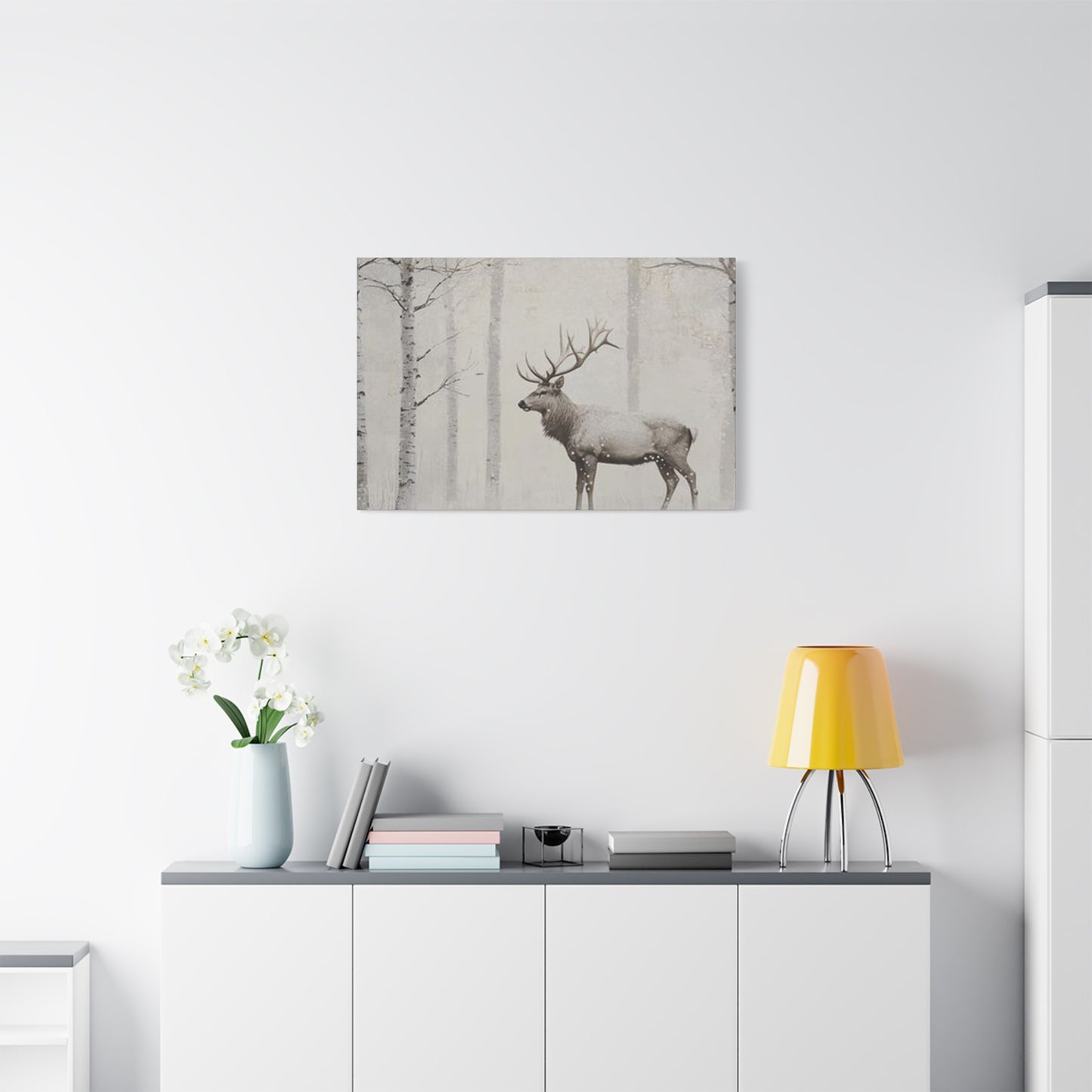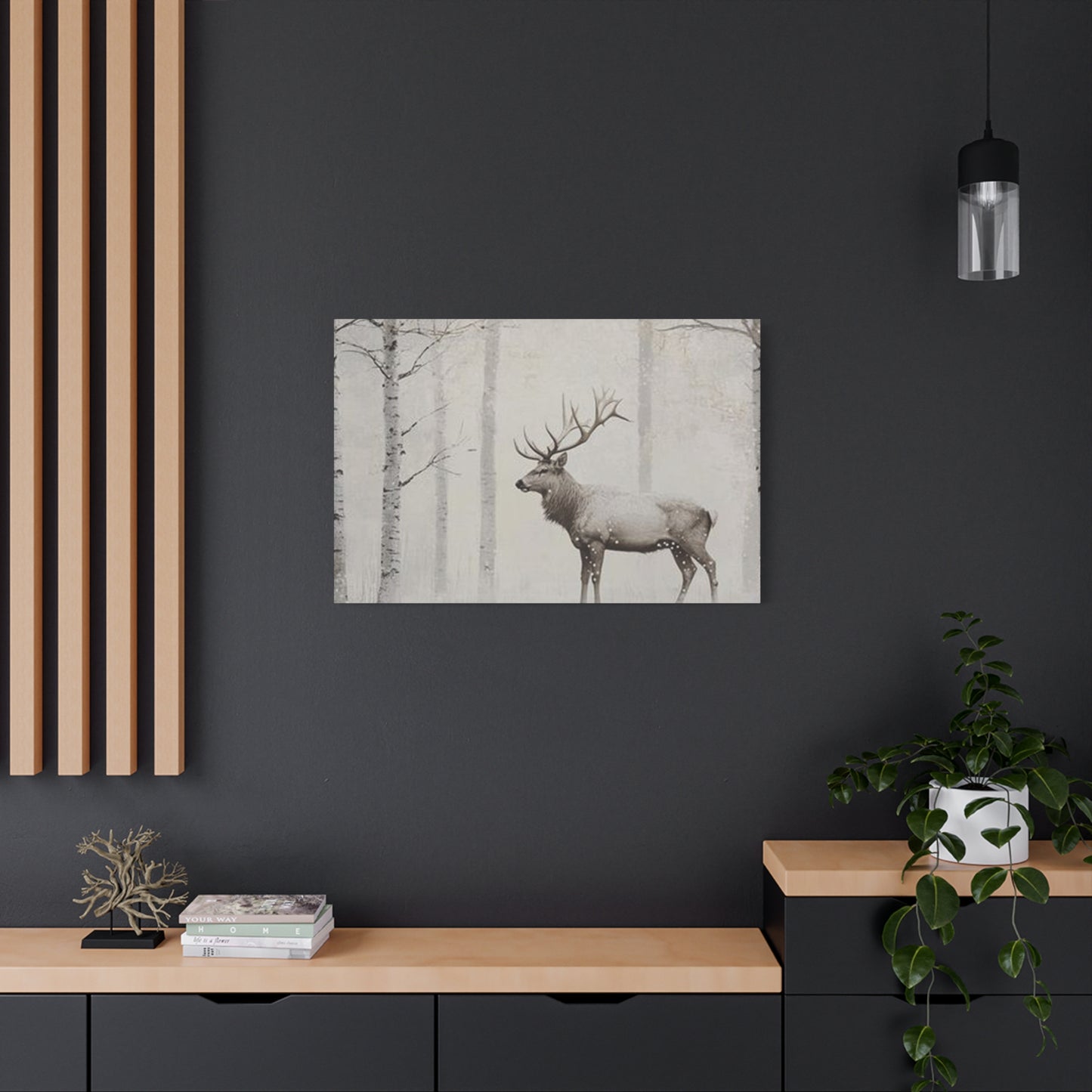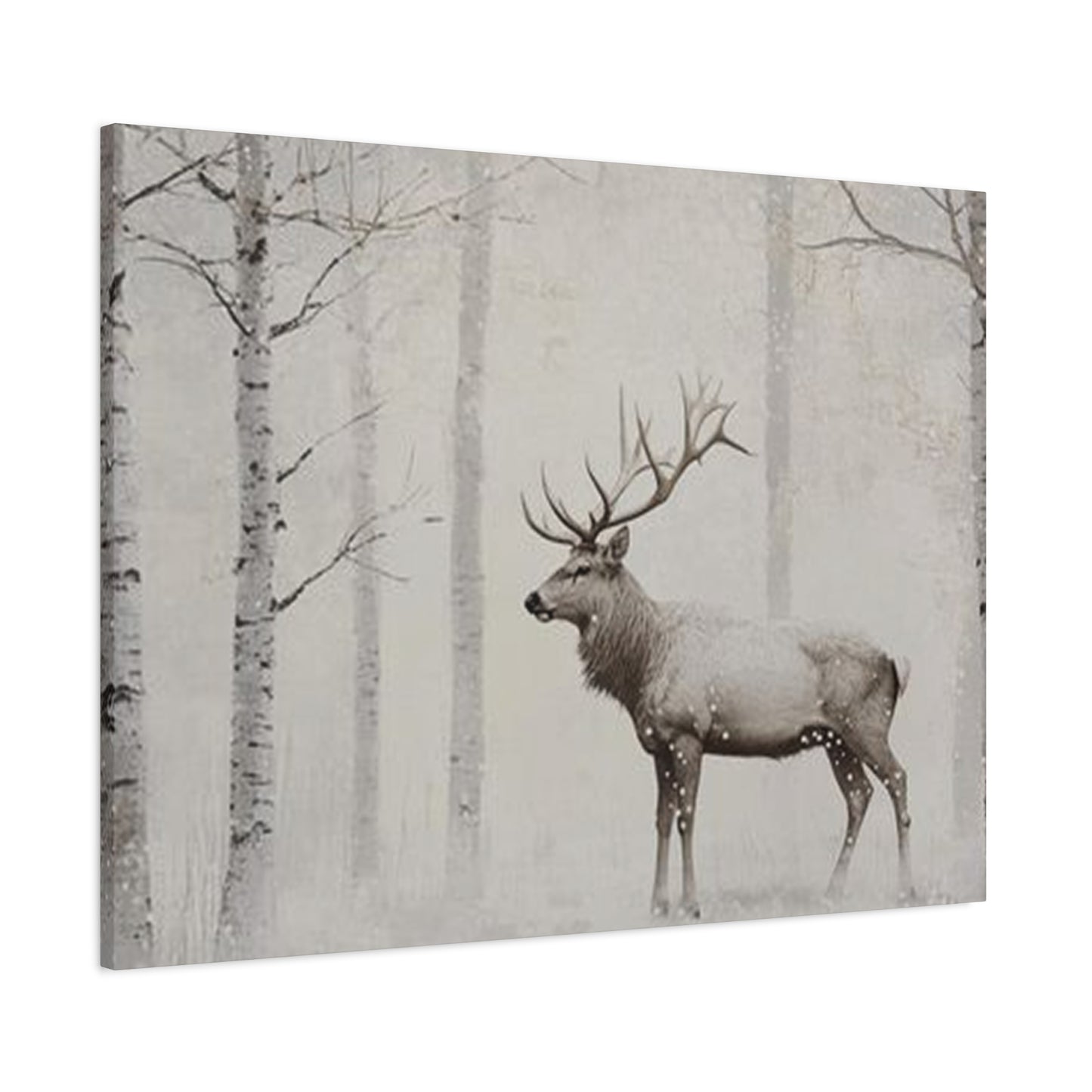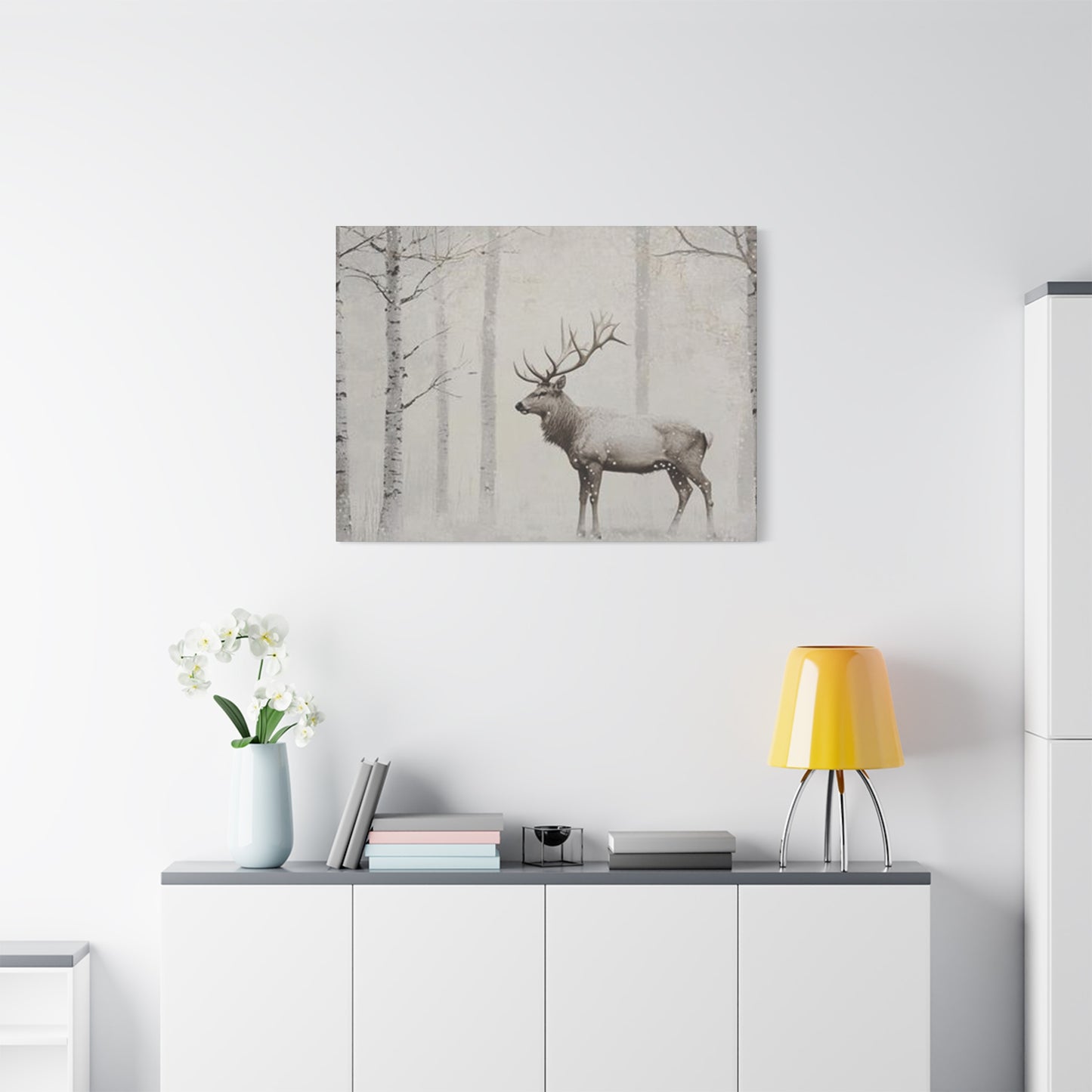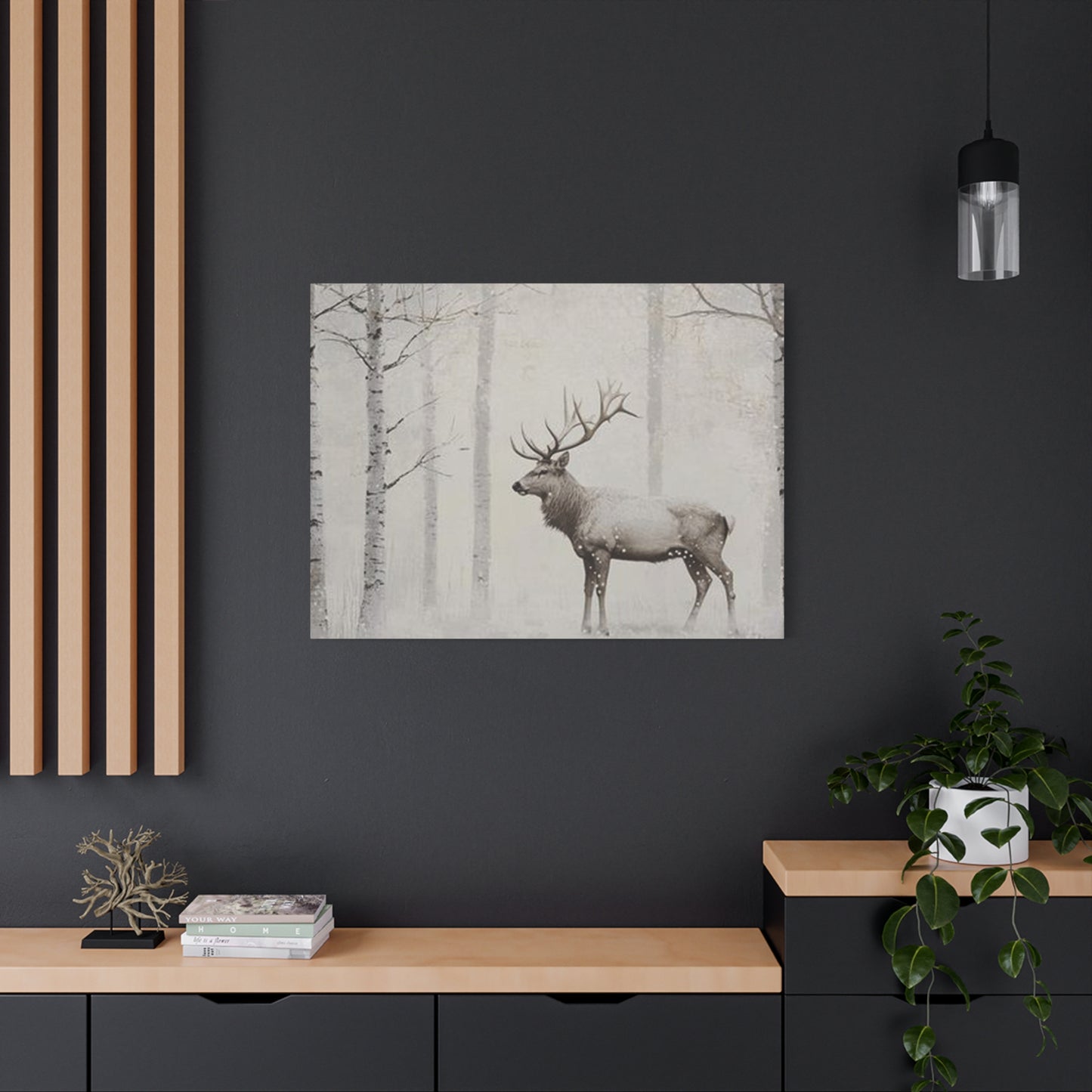Tranquil Snowy Deer Wall Art: Capturing Winter’s Quiet Beauty
Winter brings with it a magical transformation of the natural world, and few images capture this enchanting season quite like deer gracefully moving through snow-covered landscapes. The combination of these majestic creatures with pristine winter scenery creates artwork that resonates deeply with viewers, offering both visual beauty and emotional tranquility. Deer in snowy settings have become increasingly popular in home decoration, providing a perfect balance between wildlife appreciation and seasonal aesthetics that can transform any room into a peaceful sanctuary.
The allure of winter deer imagery extends far beyond simple decoration. These artworks serve as windows into nature's quieter moments, capturing the serene beauty of wildlife during the most contemplative season of the year. Whether rendered in realistic detail or interpreted through abstract artistic vision, deer in snow scenes possess an inherent ability to evoke feelings of peace, reflection, and connection with the natural world. This timeless appeal makes them versatile additions to various decorating styles, from rustic cabin aesthetics to modern minimalist approaches.
The growing popularity of nature-inspired artwork reflects our collective desire to bring elements of the outdoors into our living environments. In an increasingly urbanized world, images of deer in winter landscapes offer a visual escape that can reduce stress and promote mental well-being. The soft, muted tones typically associated with snowy scenes create a calming atmosphere that complements contemporary design trends favoring neutral color palettes and organic elements.
Deer in Snow: Winter Wall Art Calm
Creating a calming atmosphere through winter deer artwork involves understanding how these images interact with our psychological and emotional responses to visual stimuli. The gentle presence of deer combined with the pristine quality of snow creates a perfect harmony that speaks to our innate connection with nature. These artworks function as visual meditation tools, offering viewers a moment of respite from the bustling pace of modern life.
The calming effect of deer in snow imagery stems from several psychological factors. The soft, muffled quality that snow brings to landscapes naturally suggests quietude and peace. When combined with the graceful, unhurried movements of deer, these images create a sense of time standing still. The neutral color palette typically found in such artwork, dominated by whites, grays, and earth tones, promotes relaxation and mental clarity.
Deer themselves carry symbolic weight in many cultures, often representing gentleness, intuition, and spiritual guidance. In winter settings, these associations become even more pronounced, as the harsh season highlights the deer's resilience and grace under challenging conditions. This symbolism adds depth to the artwork, making it more than mere decoration but a source of inspiration and contemplation.
The placement of deer in snow artwork within living areas requires careful consideration of the desired emotional impact. Bedrooms benefit from smaller, more intimate depictions that promote restful sleep, while living areas can accommodate larger, more dramatic pieces that serve as focal points for relaxation and conversation. The key is selecting images that align with the intended use of each room while maintaining the overall calming aesthetic.
Lighting plays a crucial role in maximizing the calming effects of winter deer artwork. Soft, warm lighting enhances the peaceful qualities of these images, while harsh or overly bright illumination can diminish their tranquil impact. Consider using adjustable lighting options that allow for different moods throughout the day, from bright natural light that highlights details to softer evening illumination that emphasizes the artwork's soothing qualities.
The psychological benefits of displaying calming wildlife imagery extend beyond immediate visual pleasure. Studies have shown that nature-based artwork can reduce stress hormones, lower blood pressure, and improve overall mental well-being. By incorporating deer in snow imagery into living environments, homeowners create therapeutic benefits that contribute to long-term health and happiness.
Snowy Deer Prints for Cozy Vibes
The creation of cozy atmospheres through snowy deer prints involves understanding how visual elements contribute to feelings of warmth and comfort despite the cold winter imagery. The paradox of finding warmth in winter scenes lies in the emotional associations we form with these images and how they connect to memories of comfort, safety, and home during the colder months.
Cozy vibes emerge from the interplay between the artwork's content and the surrounding environment. Snowy deer prints work particularly well in rooms designed for relaxation and intimate gatherings. The soft textures implied in snow-covered scenes complement physical textures in the room, such as warm blankets, plush rugs, and comfortable seating. This visual-tactile connection enhances the overall sensory experience of coziness.
The choice of print medium significantly impacts the cozy factor of snowy deer artwork. Canvas prints offer a softer, more organic feel that complements cozy aesthetics, while high-quality paper prints can provide crisp detail that draws viewers into the scene. Textured printing techniques that emphasize the natural elements in the artwork, such as the roughness of tree bark or the softness of snow, contribute to the tactile appeal that defines cozy environments.
Color temperature plays a vital role in creating cozy vibes with winter imagery. While snow is typically associated with cool blues and whites, the most effective cozy deer prints incorporate warmer undertones that suggest the golden light of winter sunrise or the amber glow of late afternoon sun filtering through snow-laden trees. These warm accents prevent the artwork from feeling cold or unwelcoming while maintaining the winter theme.
Scale considerations become particularly important when using snowy deer prints to create cozy atmospheres. Multiple smaller prints arranged in groupings can create intimate vignettes that feel more personal and cozy than single large pieces. This approach allows for varied compositions that can be adjusted seasonally or as decorating preferences evolve, maintaining the fresh appeal that keeps cozy environments from becoming stagnant.
The integration of snowy deer prints with other cozy elements requires thoughtful coordination. Natural materials such as wood frames, woven baskets, and ceramic accessories complement the organic nature of the wildlife imagery. Layering different textures and materials creates depth and visual interest that enhances the cozy atmosphere while allowing the deer artwork to serve as a unifying natural element.
Choosing Deer in Snow Canvas Size
Selecting the appropriate canvas size for deer in snow artwork requires careful consideration of multiple factors including room dimensions, viewing distance, and the desired visual impact. The relationship between artwork size and room proportions significantly affects how the piece integrates with the existing decor and influences the overall aesthetic balance of the environment.
Room size serves as the primary determinant for canvas dimensions, but the relationship is not simply proportional. Large rooms can accommodate oversized canvases that make bold statements, but they can also benefit from smaller pieces that create intimate viewing experiences within the larger context. The key is understanding how different sizes affect the viewer's relationship with the artwork and the room as a whole.
Viewing distance calculations help determine optimal canvas sizes for specific locations. Artwork meant to be viewed from across a room requires larger dimensions to maintain visual impact, while pieces positioned for close examination can be more modestly sized. Deer in snow scenes particularly benefit from this consideration, as the peaceful nature of the subject matter often invites closer contemplation.
Wall proportion guidelines suggest that artwork should occupy approximately 60-75% of the available wall width for optimal visual balance. However, deer in snow canvases can effectively break these rules when used as part of gallery walls or when creating specific design effects. The serene nature of winter deer imagery allows for more flexibility in sizing approaches than more dramatic or busy artwork.
Furniture relationships influence canvas size selections significantly. Artwork hanging above sofas, beds, or console tables should relate proportionally to these pieces while maintaining adequate spacing. Deer in snow canvases work particularly well in these applications because their calming nature complements the restful functions of furniture in living and sleeping areas.
Multiple canvas arrangements offer alternatives to single large pieces, allowing for creative sizing solutions that adapt to various architectural constraints. Triptychs or series of related deer in snow images can create dramatic impact while working within smaller individual canvas limitations. This approach also provides flexibility for future rearrangement or expansion of the collection.
The emotional impact of canvas size should not be overlooked when selecting deer in snow artwork. Larger canvases create immersive experiences that can transport viewers into the winter landscape, while smaller pieces offer intimate moments of contemplation. Understanding the desired emotional response helps guide size selection to achieve specific atmospheric goals within different living areas.
Framing Tips for Snowy Deer Art
The framing of snowy deer artwork requires careful consideration of materials, colors, and styles that enhance rather than compete with the delicate beauty of winter wildlife imagery. The frame serves as a transition between the artwork and the surrounding environment, making its selection crucial to the overall visual success of the piece.
Material selection for frames should complement the natural elements present in deer in snow artwork. Wood frames, particularly those with natural finishes or subtle stains, create harmony with the organic subject matter. The grain and texture of wood echo the natural textures found in winter forests, creating a cohesive aesthetic that feels authentic and grounded in nature.
Color coordination between frames and artwork requires understanding the dominant tones in snowy deer images. While white or light-colored frames might seem like obvious choices for snow scenes, they can sometimes wash out the subtle contrasts that make these images compelling. Darker frames can provide necessary contrast while still complementing the winter theme through appropriate material and finish choices.
Frame width considerations affect how viewers perceive the scale and importance of deer in snow artwork. Wider frames create more formal presentations that work well in traditional or transitional decorating styles, while thinner frames maintain focus on the artwork itself and suit contemporary or minimalist approaches. The peaceful nature of deer imagery often benefits from frames that don't overpower the subtle beauty of the subject matter.
Matting decisions significantly impact the presentation of snowy deer prints. White or cream mats can extend the snowy feeling of the artwork while providing necessary visual breathing room. However, colored mats in soft earth tones can add warmth and richness that prevents the overall presentation from feeling too cold or stark. The width of matting should be proportional to both the artwork size and the frame width.
Glass and glazing choices affect both the protection and appearance of deer in snow artwork. Non-reflective glass reduces glare that can interfere with viewing, particularly important for pieces hung in areas with variable lighting conditions. UV-protective glazing helps preserve the subtle color variations that make winter deer imagery so appealing, preventing fading that could diminish the artwork's impact over time.
Custom framing versus ready-made options presents different advantages for deer in snow artwork. Custom framing allows for perfect proportions and material matching but requires higher investment. Ready-made frames offer convenience and cost savings but may require compromises in proportion or material choice. The decision often depends on the artwork's intended permanence and importance within the overall decorating scheme.
Symbolism of Deer and Snow
The symbolic significance of deer in snowy landscapes draws from deep cultural associations that span across various traditions and belief systems. Understanding these symbolic meanings adds layers of appreciation to deer in snow artwork and can influence how these pieces are incorporated into personal living environments.
Deer symbolism encompasses gentleness, grace, and spiritual awareness across many cultures. These creatures are often viewed as messengers between the physical and spiritual worlds, possessing an almost mystical quality that resonates with viewers seeking deeper meaning in their surroundings. In winter settings, these symbolic associations become amplified by the season's natural tendency toward reflection and contemplation.
Snow symbolism brings its own rich tradition of meaning, representing purity, transformation, and renewal. The blank slate that snow creates in landscapes mirrors psychological and spiritual concepts of new beginnings and cleansing. When combined with deer imagery, snow reinforces themes of innocence and natural wisdom that transcend mere aesthetic appreciation.
The intersection of deer and snow symbolism creates particularly powerful meaning combinations. The survival and grace of deer in harsh winter conditions symbolize resilience, adaptation, and finding beauty in challenging circumstances. This symbolism makes deer in snow artwork particularly meaningful for individuals facing transitions or seeking inspiration during difficult periods.
Cultural variations in deer and snow symbolism provide rich contexts for understanding these images. Native American traditions often view deer as gentle guides and teachers, while snow represents the quiet wisdom of winter months when nature rests and regenerates. European folklore associates deer with nobility and spiritual purity, enhanced by snow's connection to divine providence and protection.
Personal symbolic interpretations of deer and snow imagery often develop through individual experiences and associations. Childhood memories of winter wildlife encounters, seasonal traditions, or moments of peace found in snowy landscapes can imbue these artworks with deeply personal significance that enhances their decorative value through emotional connection.
The psychological impact of symbolic imagery in living environments should not be underestimated. Artwork that carries meaningful symbolism can serve as daily reminders of important values, goals, or aspirations. Deer in snow pieces can function as visual anchors for meditation, reflection, or simply as sources of comfort during stressful times.
Contemporary interpretations of deer and snow symbolism continue to evolve, incorporating modern environmental consciousness and wellness awareness. These images may represent the harmony between human life and nature, the importance of mindfulness and presence, or the beauty found in simplicity and natural living.
Mixing Snow Deer Prints with Decor
The integration of snow deer prints with existing decor requires understanding how these specific images interact with different design elements, color schemes, and stylistic approaches. Successful mixing creates cohesive environments where the artwork enhances rather than conflicts with other decorative choices.
Color coordination strategies for snow deer prints involve identifying the subtle color variations within the artwork and echoing them throughout the room. While these images predominantly feature neutral tones, they often contain warm undertones in the deer's fur or cool highlights in the snow that can be picked up in throw pillows, blankets, or accent pieces.
Texture mixing opportunities abound when incorporating snow deer prints into room designs. The implied softness of snow and fur in the artwork can be echoed through plush textiles, while the rougher textures of winter trees can be reflected in natural wood elements or woven materials. This tactile coordination creates sensory richness that enhances the overall decorative impact.
Style compatibility considerations help determine how snow deer prints fit within different decorating approaches. Rustic and cabin styles naturally complement wildlife imagery, while contemporary and minimalist approaches can embrace these prints for their calming qualities and neutral color palettes. Even traditional decorating styles can incorporate deer in snow artwork when properly framed and positioned.
Seasonal decorating approaches allow snow deer prints to serve different functions throughout the year. During winter months, these images can be primary decorative elements supported by complementary seasonal accessories. In other seasons, they can serve as year-round neutral artwork that provides subtle natural theming without overwhelming seasonal changes.
Scale balancing becomes important when mixing snow deer prints with other artwork and decorative elements. These pieces work well as part of gallery walls when balanced with complementary images of similar visual weight. They can also serve as anchor pieces around which smaller accessories and decorative items are arranged.
Lighting integration affects how snow deer prints interact with surrounding decor. The artwork can be highlighted with picture lights or incorporated into overall room lighting schemes that enhance the winter mood. The soft, reflective qualities of snow in the images can be used to brighten darker corners or create focal points within larger decorative arrangements.
Furniture pairing strategies consider how snow deer prints relate to different furniture styles and arrangements. These images work particularly well above seating areas where their calming qualities enhance relaxation, but they can also complement dining areas, bedrooms, or home offices depending on size and style choices.
Popular Deer in Snow Artists
The world of deer in snow artwork encompasses a diverse range of artistic styles and approaches, from photorealistic wildlife painters to contemporary artists who interpret winter deer imagery through modern artistic lenses. Understanding different artistic approaches helps in selecting pieces that align with personal preferences and decorating goals.
Traditional wildlife artists have long been drawn to deer in winter settings, creating detailed realistic works that celebrate the natural beauty of these creatures in their seasonal habitat. These artists often spend considerable time observing deer behavior in winter conditions, resulting in artwork that captures authentic moments of wildlife interaction with snowy environments.
Contemporary interpretations of deer in snow themes embrace various artistic movements and techniques, from impressionistic approaches that capture mood and atmosphere to abstract representations that distill the essence of winter deer encounters into simplified forms and colors. These modern approaches offer alternatives to traditional wildlife art while maintaining the emotional appeal of the subject matter.
Photographic artistry represents another significant category within deer in snow imagery, with wildlife photographers capturing stunning moments of deer in natural winter settings. These photographic works can be printed on canvas or high-quality papers to create artwork that brings the immediacy and authenticity of real wildlife encounters into home environments.
Digital art innovations have opened new possibilities for deer in snow imagery, allowing artists to combine photographic elements with painted effects or to create entirely digital compositions that push the boundaries of traditional wildlife art. These technological approaches can result in unique pieces that offer fresh perspectives on familiar themes.
Regional artistic traditions influence how deer in snow themes are interpreted and presented. Artists from different geographic areas bring their local knowledge of winter conditions and deer behavior to their work, resulting in imagery that reflects specific landscapes and seasonal experiences. This regional variation adds authenticity and diversity to the available artwork options.
Emerging artists continue to find inspiration in deer and snow themes, bringing fresh perspectives and contemporary sensibilities to this traditional subject matter. Supporting emerging artists not only provides unique artwork options but also contributes to the continued evolution and vitality of this artistic genre.
Collectibility factors influence the long-term value and appeal of deer in snow artwork from different artists. Limited edition prints, original paintings, and works by recognized artists may appreciate in value over time, making them both decorative choices and potential investments.
Abstract Snowy Deer Paintings
Abstract interpretations of snowy deer themes offer unique opportunities to capture the essence and emotion of winter wildlife encounters while departing from literal representation. These artistic approaches can create powerful visual impacts that resonate with viewers on emotional and spiritual levels beyond simple recognition of subject matter.
Color abstraction in snowy deer paintings often emphasizes the emotional temperature of winter scenes rather than literal color representation. Cool blues and whites might be balanced with warm oranges or pinks to suggest the play of light at different times of day, while earth tones can ground the composition in natural authenticity even when forms are simplified or stylized.
Form simplification techniques allow artists to distill deer and snow imagery down to essential elements that convey meaning without unnecessary detail. Curved lines might suggest deer forms while angular shapes represent snow-covered branches, creating compositions that invite viewer participation in completing the visual narrative through imagination and personal interpretation.
Texture emphasis becomes particularly important in abstract deer and snow paintings, where surface treatment can convey the tactile qualities of winter environments. Thick impasto techniques might represent snow accumulation while smooth, flowing brushwork could suggest the graceful movement of deer through winter landscapes.
Compositional freedom in abstract approaches allows for experimental arrangements that might not occur in nature but create powerful artistic statements about the relationship between wildlife and winter conditions. Deer forms might be fragmented and scattered throughout the composition, or snow effects might dominate the canvas with deer presence suggested rather than explicitly shown.
Emotional expression through abstract deer and snow imagery can communicate feelings and experiences that literal representation might not capture effectively. The loneliness of winter, the resilience of wildlife, or the spiritual connection between humans and nature can all be conveyed through abstract artistic interpretation.
Contemporary relevance of abstract wildlife art reflects current interests in environmental consciousness and mindful living. Abstract deer in snow paintings can serve as meditation on our relationship with nature while providing sophisticated artistic statements that complement contemporary decorating sensibilities.
Viewer interpretation plays a crucial role in the success of abstract snowy deer artwork, as these pieces require active engagement from observers to complete their meaning. This interactive quality can make abstract deer and snow paintings particularly rewarding choices for individuals who appreciate artwork that reveals new aspects through continued viewing.
Where to Hang Deer in Snow Art
The placement of deer in snow artwork significantly impacts both its visual effectiveness and its ability to enhance the atmosphere of different living areas. Strategic positioning considers factors such as lighting conditions, traffic patterns, viewing angles, and the functional purposes of different rooms to maximize the artwork's contribution to the overall environment.
Living room placement options for deer in snow artwork take advantage of these areas' central role in home life and entertainment. Large pieces can serve as focal points above fireplaces or main seating areas, while smaller works might be incorporated into gallery walls or positioned to complement furniture arrangements. The calming nature of winter deer imagery makes it particularly suitable for relaxation areas.
Bedroom applications of deer in snow art capitalize on the peaceful, restful qualities of these images to support better sleep and relaxation. Positioning artwork where it can be viewed from the bed creates opportunities for morning meditation or evening contemplation, while avoiding overwhelming imagery that might interfere with rest.
Dining area considerations include the social aspects of meals and gatherings, where deer in snow artwork can contribute to pleasant conversation and relaxed dining experiences. The neutral, calming qualities of winter wildlife imagery make it suitable for areas where people gather for extended periods.
Home office integration of deer in snow art can provide visual breaks from work-related stress and technology-focused activities. The natural subject matter offers mental respite during busy workdays, while the generally neutral color palettes won't distract from productive activities.
Hallway and transitional area placements take advantage of natural pause points in daily movement patterns, creating moments of visual pleasure during routine activities. Deer in snow artwork in these locations can help establish overall home atmosphere while making functional areas more visually interesting.
Bathroom applications of deer in snow imagery might seem unexpected, but these private areas offer opportunities for quiet contemplation that complement the peaceful nature of winter wildlife art. Proper humidity protection becomes important in these environments, but the calming effects can enhance daily self-care routines.
Height and viewing angle considerations affect how effectively deer in snow artwork communicates its intended emotional impact. Eye-level positioning generally provides the most engaging viewing experience, but specific room functions and furniture arrangements may require adjustments to these general guidelines.
Gifting Deer in Snow Wall Art
The selection and presentation of deer in snow artwork as gifts requires understanding the recipient's preferences, living situation, and the symbolic meanings that make these pieces particularly appropriate for various occasions and relationships. The universal appeal of winter wildlife imagery makes it suitable for diverse gift-giving scenarios while offering meaningful artistic value.
Occasion appropriateness for deer in snow artwork spans numerous celebrations and milestones. Housewarming gifts benefit from the welcoming, peaceful nature of these images, while holiday presents can embrace the winter theme. Wedding gifts might emphasize the symbolic meanings of grace and partnership, while retirement presents could celebrate new beginnings and peaceful transitions.
Recipient consideration involves understanding personal tastes, existing decor, and lifestyle factors that influence how deer in snow artwork might be received and used. Nature lovers and outdoor enthusiasts represent obvious target recipients, but the calming qualities of these images appeal to anyone seeking stress reduction and natural beauty in their living environment.
Size and format decisions for gift-giving often favor versatility and ease of display. Medium-sized prints in standard frame sizes offer recipients flexibility in placement and integration with existing decor. Ready-to-hang options eliminate barriers to immediate enjoyment, while custom framing services can add personal touches that enhance the gift's perceived value.
Presentation enhancement through thoughtful packaging and accompanying materials can significantly impact the gift recipient's experience. Information about the artist, the symbolic meanings of deer and snow imagery, or care instructions for the artwork adds value and demonstrates thoughtfulness beyond the artwork itself.
Personalization opportunities might include custom matting in colors that complement the recipient's known preferences, inscription options for special occasions, or selection of specific deer and snow scenes that relate to shared experiences or memories.
Budget considerations encompass various price points from affordable prints to original artwork, allowing gift-givers to find appropriate options regardless of financial constraints. The emotional value of thoughtfully selected deer in snow artwork often exceeds its monetary cost, making it a meaningful choice at any budget level.
Long-term appreciation factors consider how deer in snow artwork might continue to provide pleasure and meaning over time. The timeless nature of wildlife and winter themes, combined with the enduring appeal of peaceful imagery, suggests that these gifts will remain relevant and appreciated long after the initial presentation.
DIY Deer in Snow Canvas Ideas
Creating personal deer in snow artwork through DIY projects offers opportunities for artistic expression while producing customized pieces that perfectly match individual preferences and decorating needs. These projects can range from simple reproduction techniques to original artistic interpretations that reflect personal experiences with winter wildlife.
Basic reproduction techniques allow individuals with limited artistic experience to create deer in snow artwork using existing images as inspiration. Transfer methods, stenciling approaches, and guided painting techniques can help produce satisfying results while building confidence for more advanced projects.
Photographic manipulation projects combine personal winter photographs with digital editing techniques to create unique deer in snow compositions. These approaches might involve adding deer elements to existing winter landscape photographs or enhancing wildlife photos with artistic snow effects.
Mixed media approaches incorporate various materials and techniques to create textured, dimensional deer in snow artwork. Combining painting with collage elements, natural materials, or fabric can produce unique pieces that capture both visual and tactile qualities of winter wildlife scenes.
Stencil and template methods provide structured approaches to creating deer in snow artwork while allowing for personal color and style choices. Pre-made stencils can be combined and customized, while hand-drawn templates enable completely original compositions based on personal vision and creativity.
Family project opportunities make deer in snow artwork creation into shared activities that can produce meaningful keepsakes while providing educational experiences about wildlife and seasonal changes. Simple techniques can be adapted for different age groups and skill levels within family settings.
Seasonal creation projects align artwork production with winter months, taking advantage of increased indoor time and seasonal inspiration. These timing choices can also provide natural exhibition schedules where completed pieces debut during appropriate seasons.
Cost-effective material selection ensures that DIY deer in snow projects remain accessible regardless of budget constraints. Canvas panels, acrylic paints, and basic brushes provide essential supplies, while creative sourcing of additional materials can enhance projects without significant expense.
Skill development progression allows DIY enthusiasts to advance from basic projects to more sophisticated techniques over time. Starting with simple approaches and gradually incorporating more complex methods provides sustainable artistic growth while maintaining enjoyment and satisfaction throughout the creative process.
Creating Peace with Snow Deer Art
The intentional use of snow deer artwork to cultivate peaceful environments involves understanding how visual elements interact with psychological well-being and emotional regulation. These images possess inherent qualities that promote tranquility, making them particularly effective tools for creating restorative living areas.
Mindfulness integration with snow deer artwork encourages present-moment awareness and stress reduction through focused visual attention. The gentle nature of deer combined with the pristine quality of snow provides ideal subjects for contemplative viewing that can interrupt anxious thought patterns and promote mental calm.
Meditation enhancement through strategic placement of snow deer images creates visual anchors for regular mindfulness practices. Positioning artwork where it can be easily viewed during meditation sessions or quiet reflection times maximizes its contribution to stress reduction and emotional balance.
Stress reduction mechanisms activated by peaceful wildlife imagery include lowered heart rate, decreased cortisol production, and improved mood regulation. The natural subject matter connects viewers with evolutionary associations between nature exposure and safety, triggering beneficial physiological responses that promote overall well-being.
Therapeutic applications of snow deer artwork extend beyond casual decoration to include specific mental health benefits for individuals dealing with anxiety, depression, or trauma recovery. The non-threatening nature of deer imagery combined with the cleansing associations of snow can provide comfort and hope during difficult healing periods.
Environmental psychology principles support the use of nature-based artwork to improve indoor environments and their psychological effects on occupants. Snow deer images contribute to biophilic design approaches that acknowledge human beings' innate connection to natural world and need for nature contact even in built environments.
Daily rhythm support through consistent exposure to peaceful imagery helps regulate circadian cycles and promote better sleep patterns. Morning or evening viewing of snow deer artwork can serve as transitional activities that help separate day and night activities while promoting appropriate mental states for different times.
Long-term wellness benefits accumulate through regular exposure to peaceful visual stimuli, contributing to reduced stress-related health problems and improved quality of life. The investment in snow deer artwork becomes an investment in ongoing mental and physical health maintenance.
Color Themes in Snowy Deer Prints
The color palettes found in snowy deer prints encompass much more than the obvious whites and grays typically associated with winter scenes. Understanding the full range of color possibilities helps in selecting artwork that complements existing decor while achieving desired emotional and aesthetic effects.
Monochromatic approaches emphasize the subtle variations within limited color ranges, often focusing on gradations of whites, grays, and blacks to create sophisticated, elegant compositions. These restricted palettes can produce dramatic effects while maintaining the serene qualities that make snow deer imagery so appealing for residential applications.
Warm undertone integration prevents snow scenes from feeling cold or unwelcoming by incorporating subtle hints of cream, beige, or pale yellow that suggest sunlight filtering through winter forests. These warm notes can make the artwork more inviting while maintaining the winter theme and peaceful atmosphere.
Cool palette explorations embrace the natural temperature associations of winter through blues, purples, and silver tones that capture the crisp quality of winter air and the crystalline nature of snow and ice. These cooler approaches work particularly well in contemporary decorating schemes that favor clean, fresh aesthetics.
Accent color possibilities introduce small amounts of more saturated hues that can connect snow deer artwork to broader decorating color schemes. The rich browns of deer fur or the deep greens of evergreen trees provide opportunities for color coordination with existing room elements.
Seasonal color transitions consider how changing light conditions throughout the year might affect the perception of snow deer artwork colors. Pieces that appear cool and fresh in summer might seem warmer and more inviting during actual winter months, while spring and fall lighting can reveal different aspects of the color relationships.
Natural color authenticity maintains connection to real winter wildlife experiences while allowing for artistic interpretation and enhancement. Understanding the actual colors found in winter deer habitats provides foundations for both realistic and stylized artistic approaches that retain believable natural relationships.
Psychological color effects influence how different color themes in snow deer prints affect viewer emotions and responses. Cooler palettes might promote calm focus, while warmer approaches encourage comfort and relaxation, allowing for strategic color selection based on intended room atmosphere and function.
Gallery Walls with Deer in Snow
The creation of gallery walls featuring deer in snow artwork requires careful planning to achieve visual balance while maximizing the impact of winter wildlife imagery. These arrangements can showcase multiple pieces while creating cohesive displays that enhance rather than overwhelm living areas.
Composition strategies for deer in snow gallery walls consider the relationships between individual pieces and their collective effect. Symmetrical arrangements provide formal elegance, while asymmetrical compositions can create dynamic visual interest that maintains viewer attention without sacrificing the peaceful qualities of the subject matter.
Size variation techniques use different dimensions to create rhythm and prevent monotony in gallery wall displays. Large anchor pieces can be balanced with smaller supporting works, while medium-sized prints might serve as transitional elements that help unify the overall arrangement.
Frame coordination across multiple deer in snow pieces ensures visual coherence while allowing for individual artwork characteristics. Matching frames create formal unity, while coordinated but varied framing approaches can add interest without creating visual chaos that detracts from the artwork itself.
Spacing considerations affect how individual pieces relate to each other and to the wall as a whole. Consistent spacing creates orderly, peaceful arrangements that complement the serene nature of snow deer imagery, while varied spacing can introduce subtle dynamism that prevents overly static presentations.
Theme development within deer in snow gallery walls might explore different seasonal moments, artistic styles, or compositional approaches while maintaining subject matter consistency. These thematic connections help create narrative flow that encourages extended viewing and appreciation.
Lighting design for gallery walls requires even illumination that prevents some pieces from being overshadowed while others receive excessive attention. Track lighting or multiple picture lights can provide flexible solutions that adapt to different viewing conditions and times of day.
Evolution planning allows gallery walls to grow and change over time as new deer in snow artwork is acquired or as seasonal preferences shift. Modular approaches to hanging systems facilitate rearrangement without wall damage, while planned expansion areas accommodate future additions to the collection.
Caring for Deer in Snow Canvas Art
Proper maintenance and care of deer in snow canvas artwork ensures long-term preservation of both artistic and monetary value while maintaining the visual appeal that makes these pieces desirable decorative elements. Understanding basic conservation principles helps protect investments in quality artwork.
Cleaning techniques for canvas artwork require gentle approaches that remove dust and surface dirt without damaging paint layers or canvas materials. Soft brush cleaning removes loose particles, while slightly damp cloth application can address more stubborn surface contamination when applied carefully to avoid over-wetting.
Environmental protection involves controlling factors such as humidity, temperature, and light exposure that can cause gradual degradation of canvas artwork over time. Stable environmental conditions prevent expansion and contraction cycles that stress canvas and paint, while appropriate humidity levels prevent mold growth without over-drying materials.
UV protection measures shield deer in snow canvas art from harmful ultraviolet radiation that causes fading and color shifts over time. UV-filtering glass or acrylic glazing provides protection for framed pieces, while strategic positioning away from direct sunlight helps preserve unprotected canvases.
Handling procedures minimize physical damage during cleaning, moving, or rehang activities. Proper support when moving canvas artwork prevents stress concentration that could lead to cracking or tearing, while clean hands and appropriate grip positions avoid oil transfer and pressure damage.
Storage solutions for seasonal rotation or temporary removal require acid-free materials and proper support systems that prevent creasing or pressure damage. Flat storage with adequate ventilation provides ideal conditions, while rolled storage requires careful technique to avoid permanent creasing or paint cracking.
Professional conservation consultation becomes valuable for high-value pieces or when damage has occurred that exceeds basic maintenance capabilities. Early intervention can prevent minor problems from becoming major restoration challenges that significantly impact artwork value and appearance.
Insurance considerations protect significant investments in deer in snow canvas artwork through appropriate coverage that accounts for replacement costs and appreciation in value. Documentation through photographs and appraisals supports insurance claims and helps track collection value over time.
Seasonal Decor with Deer in Snow
The integration of deer in snow artwork into seasonal decorating approaches creates opportunities for dynamic interior environments that change throughout the year while maintaining coherent aesthetic themes. These pieces can serve as year-round foundations or seasonal highlights depending on overall decorating strategies.
Winter season enhancement represents the most obvious application for deer in snow artwork, when the subject matter directly matches outdoor conditions and indoor comfort needs. During these months, the artwork can be featured prominently with supporting accessories that reinforce the winter theme and cozy atmosphere.
Year-round display approaches treat deer in snow artwork as timeless nature imagery that transcends seasonal specificity. The peaceful, neutral qualities of these pieces allow them to complement various seasonal decorating changes while providing consistent natural beauty and calming effects.
Transitional strategies use deer in snow artwork as bridge elements between different seasonal themes, maintaining visual continuity while other decorative elements change to reflect shifting seasons. The natural subject matter provides common ground that works with spring renewal themes, summer nature appreciation, and autumn harvest concepts.
Holiday integration possibilities incorporate deer in snow imagery into various celebration themes beyond obvious winter holidays. The graceful, peaceful nature of deer connects with many cultural and religious celebration themes, while snow's purification symbolism aligns with renewal and reflection themes.
Accessory coordination changes throughout the year can refresh the appearance and impact of deer in snow artwork without requiring repositioning or replacement. Seasonal pillows, throws, candles, and natural elements can create different moods and color relationships that keep familiar artwork feeling fresh and current.
Storage and rotation systems allow collections of seasonal artwork to be efficiently managed while protecting pieces during off-seasons. Proper storage maintains artwork condition, while systematic rotation schedules ensure all pieces receive appropriate display time and attention.
Planning considerations for seasonal decorating with deer in snow artwork include budget allocation for supporting accessories, storage space requirements, and time investment for seasonal changes. Successful seasonal decorating balances freshness and variety with practical constraints and maintenance requirements.
Textures in Deer Snow Paintings
The textural elements present in deer snow paintings contribute significantly to their visual impact and emotional appeal, creating tactile suggestions that enhance the viewer's connection to the winter wilderness experience. Understanding and appreciating these textural qualities can deepen appreciation for the artwork while informing selection decisions.
Snow texture representation varies dramatically between different artistic approaches and techniques, from smooth, pristine surfaces that suggest fresh snowfall to rough, wind-sculpted forms that indicate harsh winter conditions. These textural variations contribute to the narrative quality of the artwork and influence its emotional impact on viewers.
Fur texture details in deer imagery require careful artistic attention to convey the animals' winter adaptations and natural beauty. Dense winter coats, guard hairs catching light, and the subtle color variations within deer fur all contribute textural interest that makes the animals seem more lifelike and present within their winter environment.
Conclusion
Tranquil Snowy Deer Wall Art beautifully captures the serene essence of winter’s quiet beauty, offering a peaceful retreat into nature’s calmest moments. The gentle presence of the deer amidst softly falling snowflakes and frosted landscapes evokes feelings of stillness, reflection, and gentle grace. This artwork invites viewers to pause and embrace the tranquility that winter brings—a perfect way to bring a soothing, natural ambiance into any living space.
What makes this art truly special is its delicate balance of softness and detail. The subtle interplay of muted whites, cool blues, and earthy tones highlights the quiet elegance of the snowy scene while drawing attention to the gentle strength and calm poise of the deer. Whether used as a centerpiece in a cozy living room or as a calming accent in a bedroom or study, this wall art transforms any room into a sanctuary of peace and natural beauty.
Aesthetically, Tranquil Snowy Deer Wall Art complements a variety of décor styles, from rustic and farmhouse to modern minimalism. Its understated color palette and graceful composition add a layer of warmth and harmony without overwhelming the space. The imagery not only enhances your interior but also brings a seasonal touch that resonates year-round, reminding us of nature’s serene cycles and quiet wonders.
Ultimately, this wall art is more than just decoration—it is a meditation on winter’s subtle beauty and the gentle spirit of wildlife. For nature lovers, art collectors, or anyone seeking to infuse their home with calm and elegance, Tranquil Snowy Deer Wall Art offers a timeless and evocative way to celebrate the quiet magic of the season.

















